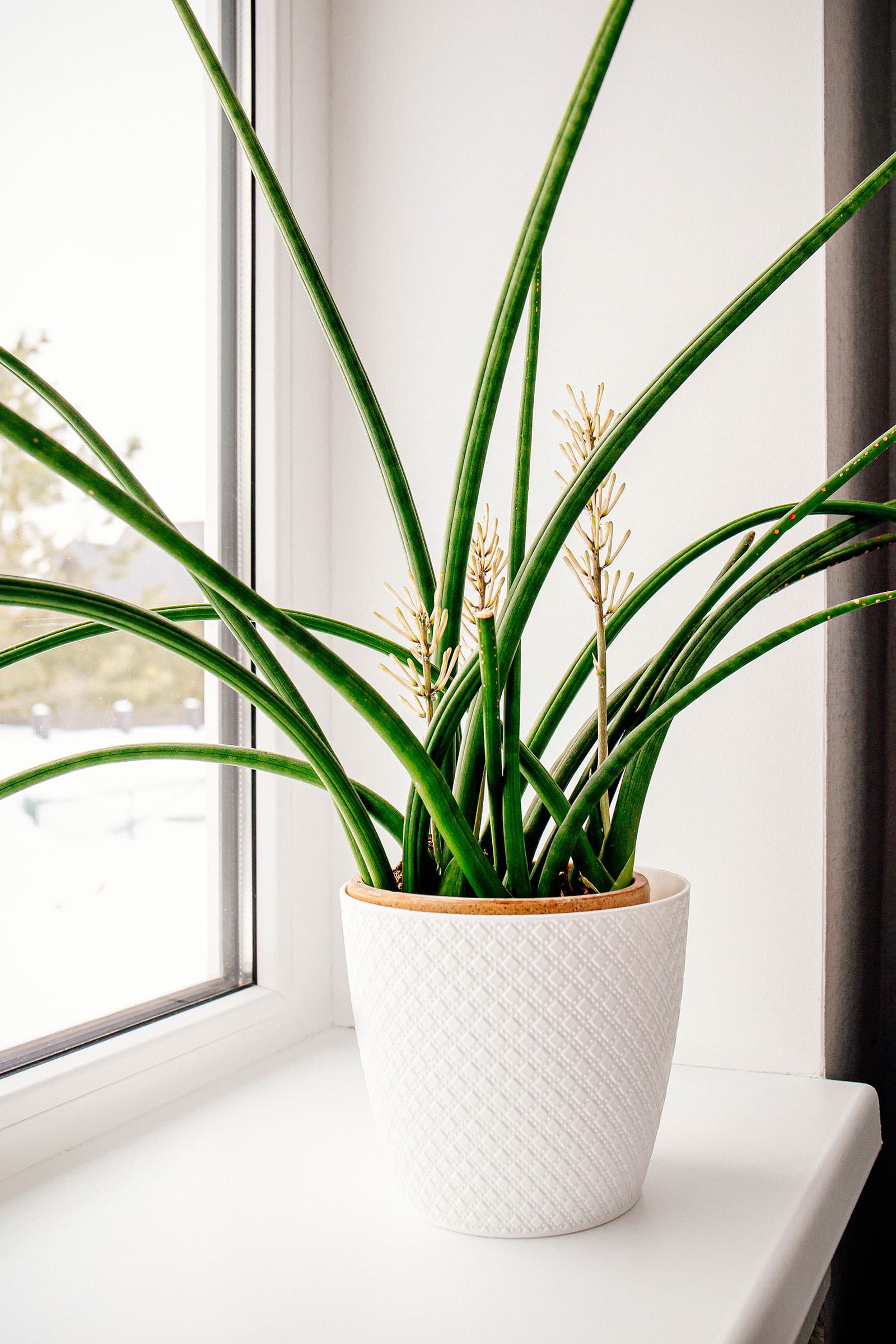Looking for a new houseplant, but worried you’ve got a black thumb? Or maybe you just want to avoid complicating things?
I’ve got just the one for you: Dracaena angolensis, more commonly known by its old scientific name, Sansevieria cylindrica.
Naturally found in arid Angola, this species has long been a favorite among houseplant collectors not just because of its good looks, but also because it’s incredibly sturdy and easy to grow (just like its distant cousin, Aspidistra eliator).
Sansevieria can tolerate low-light conditions and less-than-ideal care. Even if you’re a beginning houseplant grower, you should be able to keep your snake plant alive with just a few simple guidelines!
Below, let’s have a look at everything you need to know about growing Sansevieria cylindrica indoors.
| Common name(s) | Sansevieria cylindrica, cylindrical snake plant, African spear, bowstring hemp |
| Scientific name | Dracaena angolensis |
| Family | Asparagaceae |
| Height and spread | Up to 6 feet tall and 2 feet wide |
| Light | Direct sunlight |
| Soil type | Loose and well-draining |
| Water | When fully dry |
Disclosure: If you shop from my article or make a purchase through one of my links, I may receive commissions on some of the products I recommend.

About Sansevieria cylindrica
Description
If you’re in search of an unusual houseplant to add to your collection, you’ve found it. There’s really nothing like this funky species, which can be recognized by its stiff, tubular leaves that grow from a central rosette.
Although the Sansevieria cylindrica specimens you’ll find for sale at your local plant store tend to be small, this plant can actually grow very tall (up to around 6 feet!). Its leaves are slightly ribbed and usually have dark green, horizontal banding. They can reach over an inch in diameter.
Healthy Sansevieria plants sometimes bloom in the home. Their little white flowers grow on a long flower spike, making for a kind of brush-like look (as seen in the image above).
Sansevieria naming
If you’ve been collecting houseplants for a while, you’re likely aware that their scientific names can change. DNA research can lead botanists to discover that the family links between plants aren’t as they originally thought, which can cause species to be moved to different genera or even new genera to be erected.
This is exactly what happened to the genus Sansevieria. A 2014 study revealed that almost all of the species in this iconic houseplant genus actually belonged in the equally iconic genus Dracaena (and one in the monotypic genus Reineckea).
In some cases, like with Sansevieria cylindrica, the species name also changed.
This plant is now officially called Dracaena angolensis, although many sources continue to call it (and other former Sansevierias) by its old name. I’ll do the same here, unless I’m talking about the species in a scientific context.
The whole change led to a good bit of confusion, because the Dracaena species we’re familiar with in the houseplant world (like lucky bamboo) really don’t look much like the plants formerly known as Sansevieria at all.
Also known as dragon trees—as the name suggests—they have a more tree-like appearance. Alas, the science doesn’t lie: they’re very closely related.
Natural habitat
This plant’s new scientific name, Dracaena angolensis, gives us a pretty good clue as to where it’s from.
It’s mostly known from Angola, a country in southern Africa that features both tropical and desert habitats. Today’s subject is principally found in the latter: It’s a xerophyte, a fancy word for a plant that doesn’t need a lot of water.
Sansevieria cylindrica is also an introduced species in a bunch of different countries, including in Florida in the US. This is probably the result of plants “escaping” from parks and gardens.
Uses
As I’ve briefly mentioned, Sansevieria cylindrica is also sometimes referred to as “bowstring hemp”. This is because the leaves of plants formerly known as Sansevieria can indeed be used to produce fibers, which in turn can be twisted or braided together into rope.
Fibers made of Sansevieria cylindrica leaves are apparently pretty strong!
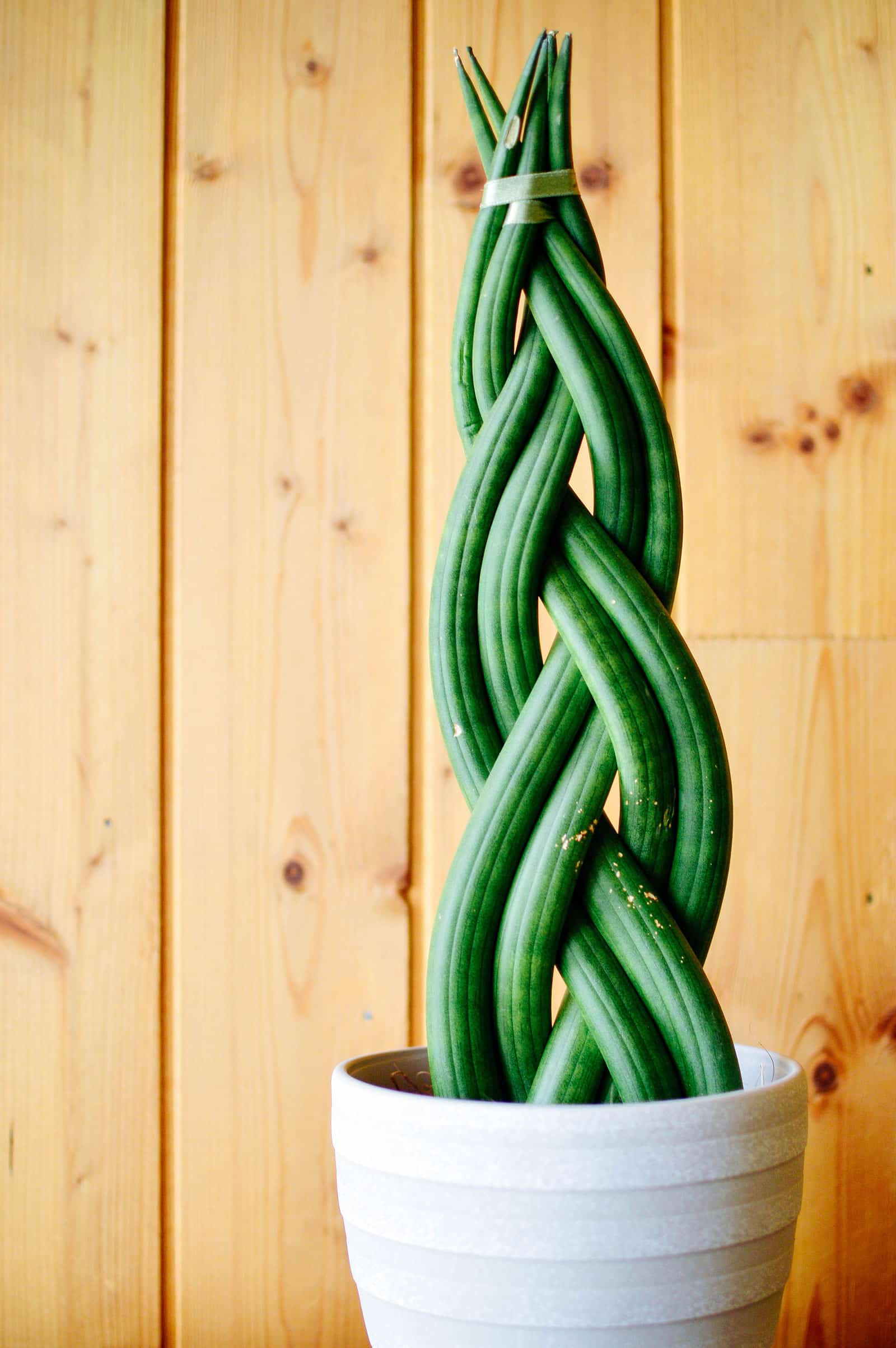
Sansevieria cylindrica varieties
As with many other houseplants, nurseries have managed to create a few different Sansevieria cylindrica varieties through selective cultivation. These are called cultivars.
Let’s have a look at the ones you may come across in your local plant store. I unfortunately can’t find patents for any of these, so it’s not really clear who created them and when.
Sansevieria cylindrica ‘Boncel’
Also known as Sansevieria cylindrica ‘Starfish’ or incorrectly as Sansevieria cylindrica boncellensis (as if it were a subspecies, which it’s not), S. cylindrica ‘Boncel’ is probably the most common cultivar of this plant.
Much more compact than the wild form of this plant, the leaves on ‘Boncel’ grow in a sort of fan shape. There’s even a ‘Dwarf Boncel’, which is supposed to stay even smaller!
Sansevieria cylindrica ‘Dragon Fingers’
Although it’s often referred to in a manner that suggests it is, I don’t think ‘Dragon Fingers’ is an actual cultivar of Sansevieria cylindrica. Rather, it’s a name often given to braided versions of the plant.
These appear to be the same as the wild type, except their leaves are braided together as they grow. It’s a neat look, and it doesn’t seem to harm the plant.
Sansevieria cylindrica ‘Mohawk’
I’ve seen this cultivar popping up for sale now and then here in the US. It looks somewhat similar to a ‘Boncel’, with a fan-like growth pattern. The difference is in the fact that the leaves point straight up rather than in all directions.
Sansevieria cylindrica ‘Medusa’
How whimsical is this one! Sansevieria ‘Medusa’ looks quite similar to the original wild-type plant, but there is a difference. The leaves don’t grow straight up, but are slightly wavy. Perfect if you want something just a little bit different.
Bonus: Sansevieria ‘Fernwood’
As so often happens with houseplants, there is some degree of confusion surrounding Sansevierias. They aren’t always labeled correctly, which means it can sometimes be difficult to figure out which species you’re actually dealing with.
One example is Sansevieria ‘Fernwood’, a cultivar often thought to be (and frequently sold as) an S. cylindrica.
It is, in fact, not! Although the two are very similar in looks, ‘Fernwood’ is actually a cross between S. parva and S. suffruticosa.
You may also find Sansevieria ‘Fernwood’ sold as ‘Mikado’, ‘Mikado Fernwood’, ‘Fernwood Punk’ and other names. You can tell it apart from S. cylindrica by its concave leaves.
Bonus #2: Sansevieria bacularis
Another plant that’s often confused with Sansevieria cylindrica (and also with Sansevieria ‘Fernwood’) is a species formerly scientifically known as S. bacularis (now Dracaena bacularis).
It’s sometimes called ‘Mikado’, which doesn’t help, as that name is also used for the aforementioned ‘Fernwood’ plant!
You can tell Sansevieria bacularis, whose care is identical to the other two, apart by the purple sheaths at the base of its leaves.
By the way, I’ve seen plants being called Sansevieria cylindrica bacularis, as if it were a subspecies. This is not correct.
Where to buy
Sansevieria cylindrica plants
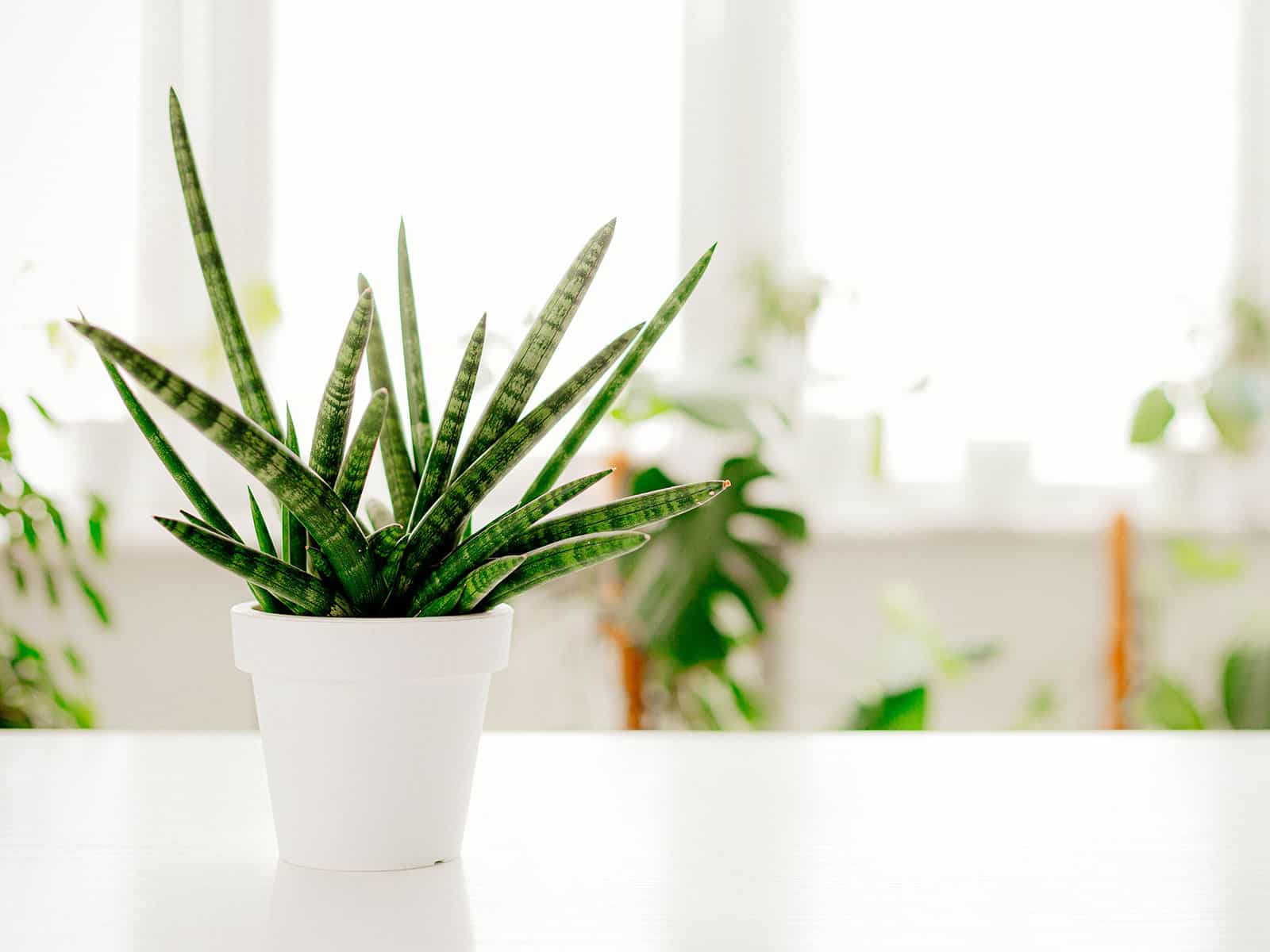
Caring for Sansevieria cylindrica
Light and temperature
When it comes to Sansevieria care, it’s important to talk about light. This genus, including S. cylindrica, is often marketed as the perfect houseplant choice for low-light locations.
Now, it’s true that Sansevierias do indeed tend to survive even if they don’t get a lot of light. They’re just really, really hardy!
But is a dark corner in your home their ideal location? Of course not—unfortunately, only fake plants do well without light.
Consider Sansevieria cylindrica’s natural habitat: open (semi-)desert with barely any cover. This plant has evolved to be used to being blasted with sun!
In your home, it will therefore actually do best directly in front of the brightest window you can offer it.
For even better growth, you can place your plant outdoors during the summer months so it can soak up the sun. If you’re in a warm climate, it can even stay there year-round.
Will your Sansevieria survive in a darker spot? Yes, it might look nice enough for a few years.
But will it grow? Unlikely. It’ll actually be dying, just in extreme slow motion.
As for temperature, these plants aren’t too fussy. As you can imagine, given where they’re from, high temps are no problem for a cylindrical snake plant.
They do best at room temperature or above, but as long as you keep its soil dry, yours should be able to survive all the way down to just above freezing (around 35°F).
Did you know?
There’s a lot of talk about a NASA study supposedly marking Sansevierias as “air purifying” plants. Unfortunately, as discussed by Nat Geo, this is oversimplifying things. Sansevieria cylindrica is very pretty, but it won’t clean the air in your home.
Soil and planting
Planting a Sansevieria is straightforward as long as you keep its xerophytic nature in mind. Your planter should always have a drainage hole, as these plants hate wet feet. Their roots can rot if they’re left standing in water.
A pot made of unglazed terracotta, a porous material that allows water to evaporate, might be ideal.
For the soil, buy or mix something nice and gritty. Store-bought succulent and cactus soils don’t tend to be well-draining enough in my opinion, so I either buy a specialty snake plant potting mix or I make my own.
It’s extremely simple and works for all kinds of succulents and cacti, not just this one:
- 1 part high-quality houseplant potting soil
- 1 part perlite
- 1 part fine orchid bark
Recommended products for Sansevieria cylindrica plant care:
- Perfect Plants Organic Snake Plant Soil
- Good Earth Organics Premium Potting Soil
- Perfect Plants Organic Perlite
- Better-Gro Orchid Bark
Water and humidity
As you’ve probably gathered, it’s generally better to underwater a Sansevieria cylindrica than to overwater it. This especially applies if your plant isn’t getting a lot of light (meaning it won’t use moisture as quickly) or if its soil doesn’t drain very well.
If you’ve got the light and soil situation under control, your snake plant will appreciate being watered whenever its soil has gone fully dry. How often that is depends on the season and conditions.
A Sansevieria cylindrica grown outdoors during high summer might want a drink every three days, while one that’s kept inside may only need water every one, maybe one-and-a-half weeks.
During winter, when your plant is likely dormant, you probably only have to water it once every month or so.
Water deeply, soaking the soil until the moisture runs out of the planter’s drainage hole, and then leave the plant alone until it has dried completely.
Humidity is really not a concern for Sansevierias at all. This is good news for the desert dwellers among us who have trouble growing moisture-loving tropicals!
Fertilizing
Sansevierias aren’t the quickest of growers, and they’re used to life in poor soil. Still, if yours is doing well, it might benefit from the occasional application of some succulent fertilizer.
You can fertilize a healthy Sansevieria cylindrica every spring using balanced liquid houseplant food. There are special snake plant fertilizers available as well!
Don’t fertilize houseplants during winter, when they’re dormant. Also, avoid doing so if your plant is struggling. Fertilizer will only make things worse in that case.
Recommended fertilizers for Sansevieria cylindrica plants:
- Elm Dirt Plant Juice Organic Fertilizer
- Houseplant Resource Center Liquid Fertilizer for Houseplants
- Leaves & Soul Professional Snake Plant Fertilizer
Pruning
A cylindrical snake plant is unlikely to need much in the way of pruning. Any dead leaves can be removed, but other than that, it should keep looking nice for years to come.
Dividing or repotting
Has your Sansevieria cylindrica outgrown its container? You must be doing something right!
You’ve got two options now: repot the entire plant into a bigger planter, or divide it up into multiple Sansevierias.
Either operation is best performed during springtime. For simple repotting, take your snake plant out of its pot and gently shake the soil from its roots. Then, pop it into a larger planter (you can go up one pot size) with fresh soil.
If you prefer division, carefully tease sets of leaves apart after you’ve taken the plant out of its pot. The roots can be a little tangled, but the separation should still be easy enough to perform.
Place each set of leaves in its own pot with Sansevieria soil and you’re all set! As they already have their own root systems, each plant should keep growing as usual.
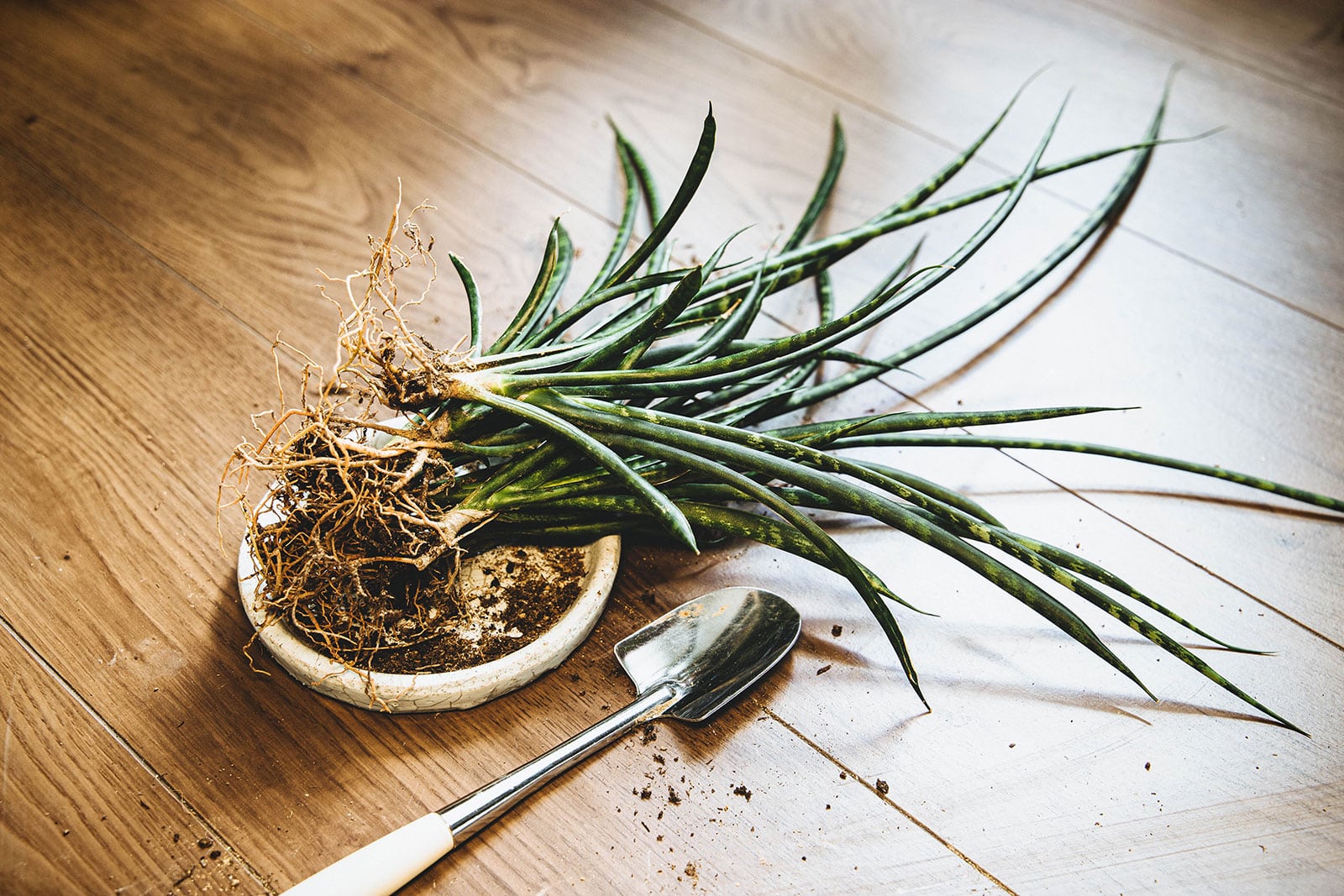
Propagating Sansevieria cylindrica
Multiplying a cylindrical snake plant is a breeze. We’ve already discussed division above, which is by far the easiest and quickest way to do it.
If you don’t want to divide your Sansevieria cylindrica or it doesn’t seem to be a good candidate for this propagation method, leaf propagation will also work. Like repotting, this is best done during the growing season (spring or summer).
Here’s how you do it:
- Cut one or more healthy leaves using clean pruning shears
- Let the leaf dry for three to four days
- Prepare a planter with Sansevieria soil
- Pop the cutting in the soil and be patient!
There’s nothing more to it. Regularly moisten the soil (though don’t overdo it, as your cutting doesn’t have roots yet) and the leaf should begin regrowing soon. It’ll focus on producing roots first.
Once you see signs of new growth popping up, which can take a few months, you’ll know your propagation attempt was a success!
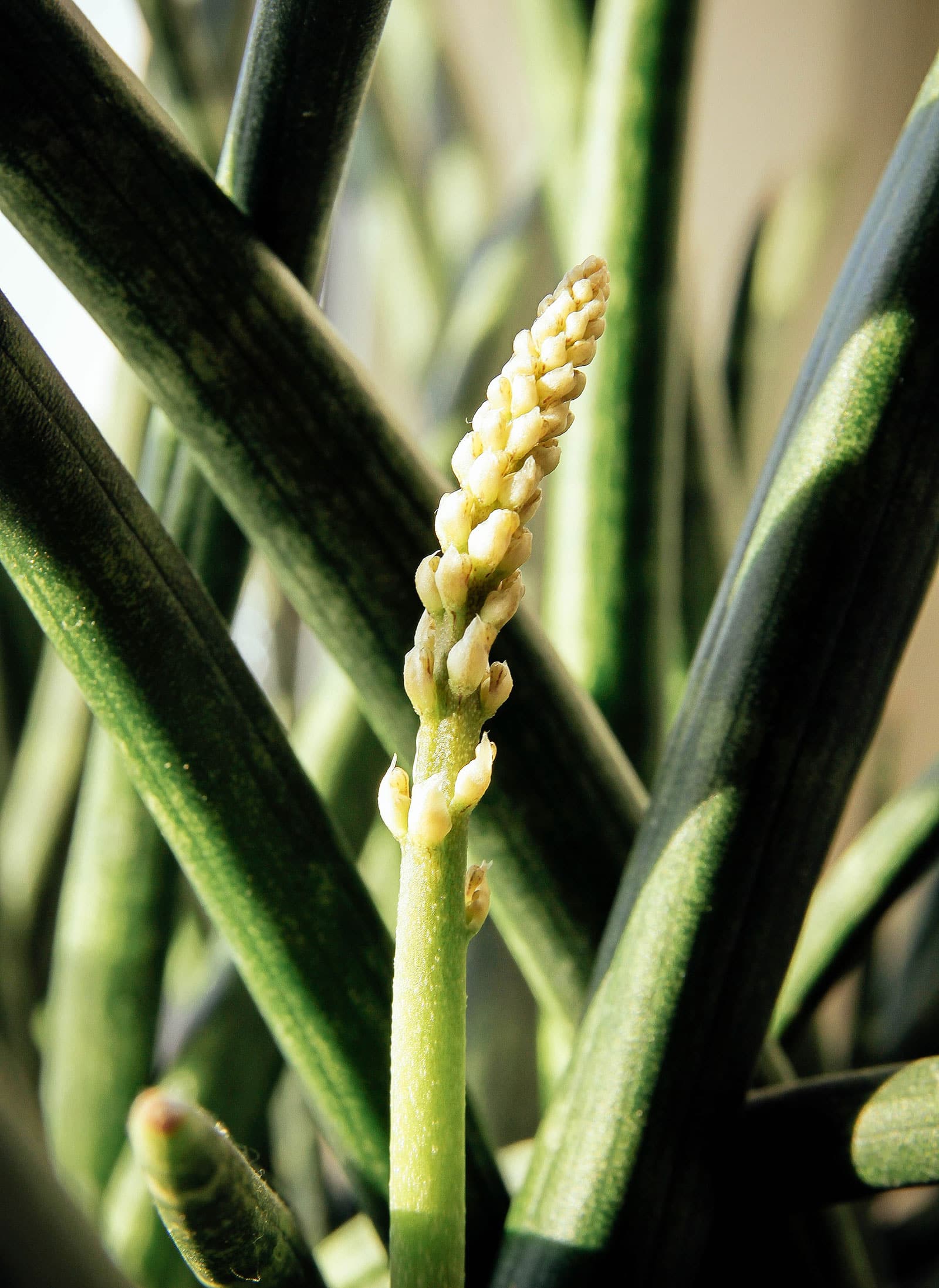
Common questions about Sansevieria cylindrica care
Is Sansevieria cylindrica toxic to cats and dogs?
According to the ASPCA, plants of the former genus Sansevieria are indeed toxic to pets and humans. They contain saponins, which cause symptoms like vomiting and diarrhea if ingested in large quantities.
Although taking a bite out of your Sansevieria is very unlikely to prove fatal to your furry friend, it’s probably still best if you keep this plant out of its reach.
How do you braid a Sansevieria cylindrica?
If you have a small and pliable cylindrical snake plant, you can opt to braid its leaves for a different look. Most folks prefer to do this while they’re repotting the plant, but you can leave it in its planter as well.
Just divide the leaves into three sections and plait them as usual. Tie the braid off at the top with a rubber band or some raffia. Repeat yearly to incorporate any new growth into the braid. That’s really all there is to it!
Sources:
- https://powo.science.kew.org/taxon/urn:lsid:ipni.org:names:77182375-1
- Balaji, N., Balasubramani, S., Ramakrishnan, T., & Sureshbabu, Y. (2020, April). Experimental investigation of chemical and tensile properties of sansevieria cylindrica fiber composites. In Materials Science Forum (Vol. 979, pp. 58-62). Trans Tech Publications Ltd.


